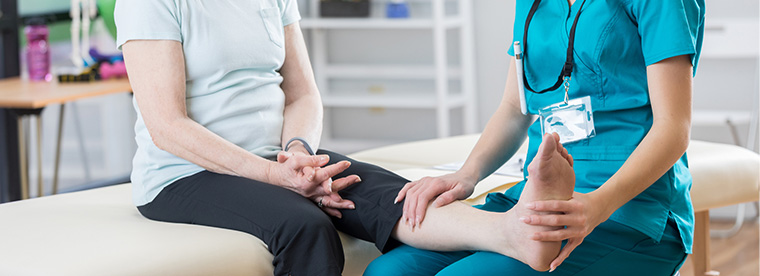Common foot problems
Many foot problems start with genetics. And while you may not be able to change the type of feet you were born with, you can influence the amount of potential pain they cause. For example, if you have wide feet and try to force them into narrow shoes, you’re going to have pain.
Foot pain frequently can be traced back to ill-fitting shoes, which can cause or aggravate foot problems. And overuse is a common culprit of foot pain as well.
Common foot conditions include:
- Achilles tendonitis: This overuse injury of the back of the heel is caused by inflammation of the tendons that connect your calf muscles to your heel bone.
- Bunion: This bony bump on the joint at the base of the big or little toe is a common deformity that causes the toe to push against the next toe. This condition can be genetic or caused by ill-fitting shoes.
- Hammertoe: In this condition, the muscles, tendons or ligament that normally hold the toe straight instead cause your toe to bend or curl downward. This condition can be genetic or caused by injury or ill-fitting shoes.
- High or low arches: An extreme arch of the foot one way or the other can cause pain, but often can be managed with an orthotic, which is a shoe insert that provides custom support.
- Morton’s neuroma: This “pinched nerve” condition occurs when a growth of tissue forms between the third and fourth toes. It can cause numbness or a burning or tingling sensation.
- Plantar fasciitis: This condition, in which the tough band of tissue that connects your heel bone to the base of your toes becomes inflamed, affects the bottom of the heel and is caused by overuse.
- Skin issues: Viral or fungal infections can cause conditions, such as athlete’s foot or warts.
How to prevent and treat foot pain
The best gift you can give your feet are shoes that fit properly and are meant for the activity in which you are participating. Try on new shoes later in the day when your feet tend to be at their biggest, and replace worn-out shoes in a timely manner.
Inspect your feet regularly, paying attention to changes in color, peeling or scaling, and growths. Catching potential problems early may prevent pain before it starts. Wash and dry your feet, including between the toes, to prevent skin infections, such as athlete’s foot.
If you have diabetes, you may need to take additional precautions to prevent foot injuries due to poor circulation.
If you develop foot pain, treatment will depend on the cause. But often, simple things can help reduce or eliminate the pain, including:
- Orthotics: Adding insoles to your shoes may provide the support you need to walk without pain. If over-the-counter insoles don’t help, we can make custom insoles.
- Physical therapy: A physical therapist can develop a plan that may include stretching, strengthening or balance exercises, or gait training.
- Injection therapy: Corticosteroid shots can help relieve pain and reduce inflammation.
If more conservative treatment doesn’t work, surgery may be necessary to remove swollen tissue, straighten a toe or repair a tendon.
The average person will walk the equivalent of more than four times around the globe. If foot pain begins to impact your life by hindering work or leisure activities, get to the doctor. You have a lot more steps to take – don’t let foot pain stop you!

